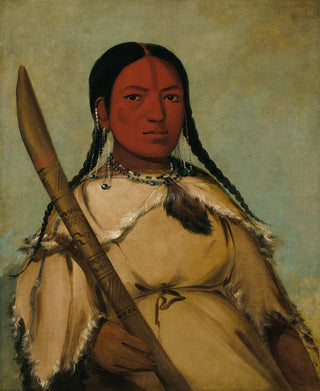Painting Chin-Cha-Pee, the fire worm that crawls, the egg-shaped head of the pigeon woman's - George Catlin | Art print


View from behind

Frame (optional)
In the fascinating world of art, some works stand out for their ability to capture not only images but also stories and emotions. The art print Chin-Cha-Pee, the fire worm that crawls, the egg-shaped head of the woman of the pigeons - George Catlin, is a perfect example. This piece, at the crossroads of cultures, evokes Native American traditions while revealing the sensitivity of an artist who was able to immerse himself in his subject. Through this painting, Catlin invites us to explore a world where nature and the human spirit meet, a world vibrant with colors and symbols.
Style and uniqueness of the work
George Catlin's style is characterized by a blend of realism and romanticism, allowing him to pay tribute to the beauty of the peoples he encountered. In this piece, the vivid colors and meticulous details combine to create an immersive atmosphere. The fire worm, emblematic of Native American culture, is depicted in a way that evokes both the strength and fragility of nature. Every element of the painting seems charged with meaning, as if Catlin sought to convey a profound message about harmony between man and his environment. The woman of the pigeons, for her part, embodies wisdom and spiritual connection with the animal world, symbolizing an ancestral tradition that deserves to be preserved.
The artist and his influence
George Catlin, born in 1796, is a pioneer of American art, recognized for his portraits and landscapes depicting Indigenous peoples of America. His passion for Native American culture led him to travel across the continent, documenting ways of life that were disappearing. Catlin transcended the simple role of painter to become a true chronicler of his time. His work has not only enriched American artistic heritage but also raised public awareness about cultural preservation issues. By examining his creations, one understands that each painting is an open window to a often little-known world, a call for reflection and mutual understanding.
A wall decoration

Matte finish

View from behind

Frame (optional)
In the fascinating world of art, some works stand out for their ability to capture not only images but also stories and emotions. The art print Chin-Cha-Pee, the fire worm that crawls, the egg-shaped head of the woman of the pigeons - George Catlin, is a perfect example. This piece, at the crossroads of cultures, evokes Native American traditions while revealing the sensitivity of an artist who was able to immerse himself in his subject. Through this painting, Catlin invites us to explore a world where nature and the human spirit meet, a world vibrant with colors and symbols.
Style and uniqueness of the work
George Catlin's style is characterized by a blend of realism and romanticism, allowing him to pay tribute to the beauty of the peoples he encountered. In this piece, the vivid colors and meticulous details combine to create an immersive atmosphere. The fire worm, emblematic of Native American culture, is depicted in a way that evokes both the strength and fragility of nature. Every element of the painting seems charged with meaning, as if Catlin sought to convey a profound message about harmony between man and his environment. The woman of the pigeons, for her part, embodies wisdom and spiritual connection with the animal world, symbolizing an ancestral tradition that deserves to be preserved.
The artist and his influence
George Catlin, born in 1796, is a pioneer of American art, recognized for his portraits and landscapes depicting Indigenous peoples of America. His passion for Native American culture led him to travel across the continent, documenting ways of life that were disappearing. Catlin transcended the simple role of painter to become a true chronicler of his time. His work has not only enriched American artistic heritage but also raised public awareness about cultural preservation issues. By examining his creations, one understands that each painting is an open window to a often little-known world, a call for reflection and mutual understanding.
A wall decoration
12,34 €






